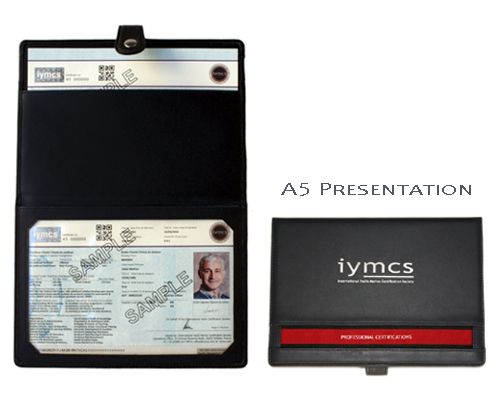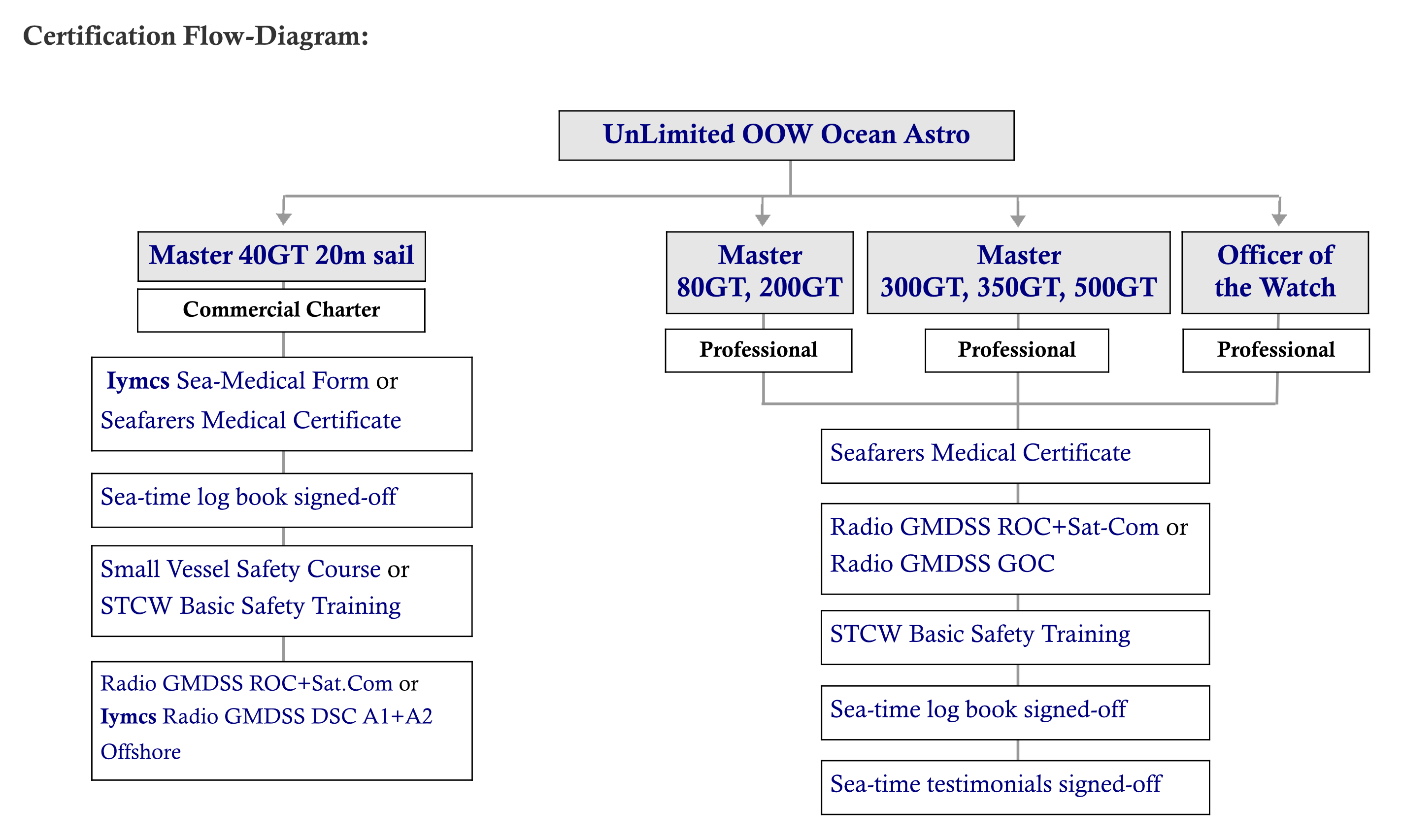
| General Details |
|---|
| Course & Certification:
ID: 6.1.13 Description: UnLimited OOW Ocean Astro™ Certification type: Certificate of Proficiency ISO 9001:2015 compliance course & certification. |
| Course Length:
A total of 87 hours consisting of; Pre-Course study = 4 hours. |
| Capacity of certification:
1. The GT or LOA is according to the existing CoC. The references to a safe haven or from the coastline of departure of the CoC have been superseded by the Endorsement, thereby it becomes a Oceanic Certification. However there maybe restrictions applied for specific operations for commercial yachts engaged in charter and for commercial work-boats in their operations. |
| Recognitions & approvals:
Pending, in process. |
| STCW Code & Codes of Practice:
Adheres to the STCW Code II/2 subject to flag recognition and acceptance. Adheres to the MCA MSN 1858. Reference standard is the STCW B-II/1.19 Celestial Navigation Syllabus. Trading Area Restrictions: |
| Certification Revalidation:
Yes required every 5 years from the date of issue. |
| Sea-time & Service On-board Requirements:
Sea Areas Category III & IV: Or; Sea Areas Category I & II: |
| Certification issuing requirements:
For Master CoC’s; 80GT, 200GT, 300GT, 350GT & 500GT: For CoC M40GT/20m sail Commercial Charter: |

The custom-designed Iymcs presentation folder type certification is stylish and practical.
The presentation folder outer is made of real leather with a sythentic interior that is resistant to water and protects the certificates.
It is A5 in size, it can hold up to four Certificates, and is an ideal size to be kept in a crew document case or with the boat's documents.
The Iymcs Certificates are printed to ISO 9001:2015 standards, are dual-language and feature extensive security features
to security level 3 (Government passports & national Iidentification documents are security levels 1 & 2) and can be used as a personal ID in daily situations.
(Nb. It cannot be used instead of a passport/national identity card).
This is a Certification that is used in conjunction with the principal CoC to lift the operational limits placed upon the certification. This is done by adding the UnLimited Endorsement to it.

Conventionally in recreational yachting, the thinking is that a student or candidate will do a series of courses and certifications starting -off with a near-coastal certification, then an offshore and finally an ocean one. In effect, a yacht master ocean certificate holder is considered by many to be a better all-round sailor than one that holds an yacht master offshore. Others would disagree and consider this to be an outdated point of view.
To add to the debate, professional commercial certifications work in a different way, you gain a base certification and then if you wish to operate full-foreign going as an Officer or Master, you are required to hold an ocean-astro endorsement to your CoC. Professional yachting CoC’s have more or less adhered to the professional commercial certification structure as mentioned before.
The Society has decided to opt for the Endorsement route which gives the flexibility to apply it to CoC’s when required as well as enabling the students or candidates to build their base CoC to their needs.
The Iymcs UnLimited OOW Ocean Astro ™ is a course that has deservedly gained a reputation for its teaching methods of this complex subject. The course is a great favourite with OOW's going up to their Chief Mates as well as for blue-water circumnavigation sailors.
The course is a compressed commercial course, with a steep learning curve with an extensive syllabus. Much of the development work of this course was undertaken by HMA Antibes, who have been teaching this course continuously over many years to OOW's and circumnavigation sailors. By using traditional and avantgarde teaching methods, this enabled the course to retain a high-level of academic underpinning knowledge and to combine it with a follow-through practical application. Throughout the course, it relates to today's navigation practices including the reference to GNSS and GMDSS. Ocean Meteorology and Oceanography is also included.
Unusually for this type of course, all the types of sights are covered and are practiced by the student themselves individually during the course and are recorded as qualifying sights for their certification. Heading checks (traditionally known as Compass Check) are also practiced using different methods.
Another unique feature of this course, is the qualifying criteria to make-up a Commercial Passage Plan Project/Thesis which is done post course. This is highly beneficial to the student, who gains knowledge on how to prepare and format properly an oceanic passage plan under the APEM principle. Another benefit, is that passed students have used their project/thesis at job interviews for a Mate, Officer or Captain. It has also been used to gain entry to maritime college.
Other key features to consider:
The course has a high rate of success in achieving a long-term subject retention by students.
The course format is designed to cater for all levels of academic ability.
There are two types of sea-time records that are required; Sea-Time Log Book and the Sea-Time testimonials that support the Log.
The diagram below shows how the Endorsements for this CoC work.

The Iymcs UnLimited OOW Ocean Astro ™ course and certificate/endorsement is well designed and throughout, the teaching standard is very high, the track record of the course for achieving student professional competency is well known amongst professional crew worldwide.

Our Society, the 'International Yacht Marine Certification Society" (Iymcs) operates its entire operations under a Quality Management System
(QMS) that is in compliance with the International Standards Organisation (ISO) 9001:2015 amended. Part of this compliance involves full auditing procedures.
This is an important reference and enables us to gain recognitions from maritime admininstrations and marine industry bodies alike.
Our Society is ISO 9001:2015 certified by the British Standards Institute (BSI) Netherlands.
The QMS together with the ISO, ensures that Iymcs and its Members operate to the highest standards possible. All our courses, and more importantly the
Certifications that we issue, are under ISO 9001:2015.
This practise is most unusual for such courses and certifications. Some organisations will claim ISO:9001 adherence but often the reality is it is for a document management
process or a similar back-office process instead of for actual operations and/or for Certification issuing.
| Scandinavia 1.800,-EUR | Northern Europe 1.700,-EUR | United Kingdom 1.500,-GBP |
| Southern Europe 1.600,-EUR | Middle East 1.600,-USD | North America 1.500,-USD |
| Prices exclude: course books,certification costs,personal traveling costs,course food and course accommodation. | ||
( Vers. 1.3. ) Click-on '+' to see Syllabus.
Mathematics revision. Concept of the Celestial Sphere. Celestial heavenly bodies. Geographical Position. The Earth. The Solar System. DR & EP revision.
Assessment test of pre-course study. Subject overview & course objective. CoC requirements. Post-course work. Course Sights planning The three key reference points for GP; centre of the earth, the equator & the UM. Chart Projections: Mercator, Gnomonic. Great Circle, Small Circle. Great Circle Sailing principles. Composite Route Tracks. Influence of the Equator. Lower & Upper Meridians 000° & 180°.
Noon Day Sight -commercial, hang-period. Sailing-by-Latitude. Short-equal-Attitudes. Plot-graph sight method. Sun -off meridian -off/on, on/off & off/on. Sun-run-Sun. Planets -on & off-meridian. Moon -on & off-meridian. Stars. Polaris. Southern Cross. Vertical Sextant Angles. Horizontal Sextant Angles. Heading checks -sun, stars, planets.
Position; lat & long, distance & bearing to/from object, GHA. Direction: principle of polar axis & great circle track, elevated pole, azimuth & zenith, true azimuth & zenith, Worlds Declination Model, local variation component, magnetic disturbances. Distance; Nm, Sm, angular, time. Speed; calculation of sxt=d for ocean passaging. Time: divisions of arbitrary and non-arbitrary, solar year & day, Apparent Noon, Greenwich Day, Solar Time UT/GMT, Atomic Clock Time UTC, Date Line, LMT/UT, conversion of arc to time, Zone Times/Shipboard Time, Standard/Geopolitical, Meridian Passage, Equation of Time.
GP Observer. Observers Zenith. Celestial Position of the Body. GP of the Body. Declination. True Meridian Zenith Distance.
Principles of the Sextant. Parts of the Sextant. Quality of the sextant. Examples of sextants. Adjustable errors. Fixed errors (certified). Student or candidate practice of adjustments (sextant is set out of line). Preparation for usage. Mirror, shades or scope change. Index Arm clamp spring repair. Maintenance & cleaning. Storage.
Sextant Altitude. Index Error. Dip. Main Altitude Errors, explanation of. Corrections Table. True Altitude principal.
History of time, John Harrison clock-maker. The Chronometer. The Deck-Watch. Atomic Clock -Worldwide stations. Time Signals ref:: ALRS. Inmarsat. Setting a time piece. The three-clock system.
Overview of the Proforma. DR & EP reference positioning. Meridian Passage (day check). GP Declination & ‘d’ value. TMZD principle. Earth sphere diagram. Relative angular distance. Steaming or sailing time. Adding & subtracting of True alt through the earth-sphere diagram. Longitude Check, equation of time calculation. Assessment of derived position.
Position Circle; distance to/from the object, bearing to/from the object. Local Hour Angle. Sight Reduction Process Overview. Establishing a Calculated or Chosen Position. Calculation of LHA, +E/-W. ‘d’ value -Table 5. Principle of Z+/-360/180 = ZN. Intercept TO/AW Bearing.
GHA +Increments. Earth Sphere Diagram.
The Bakers Plotting Sheet. The Latitude Scale. Waypoint positioning on Gnomic projection, transfer to Mercator. Position derived from two off-meridian sights, stationary vessel. Sun-Run Sun. Star/Planet Sights. Assessment of the quality of the position fix; bi-sector method and position line shifting.
Running Fix; near-coastal single object & two object, trigonometry errors, derived original position from parallelogram. The three types of Sun-run-Sun; am+noon, noon+pm, am+pm. The Proformas and order of work. Order of Plot. Assessment of derived position. Source of errors in sights, proforma & plot.
The four navigational planets. The Almanac. Off-Meridian. On-Meridian. Magnitude factor. Meridian Table (Almanac). ‘V’ correction. Proforma process. Intercept.
57x Navigational Stars. Principal constellations. Identification & location of. N.Hemp, S.Hemp, Equatorial Stars. Magnitude factor. 1st Point of Aries, creation of at 180°. SHA.
Sunset, sunrise, civil, nautical & astronomical twilight. Observation period LMT/UT. Proforma overview. Best suited stars.
1st Point of Aries. SHA. Latitude visibiity. Identity & location of. True Alt + A0 + A1 + A2 -1°. True Azimuth. Observed Latitude. Heading Check.
Southern Cross Group.
Star Sight Reduction Tables. Plotting protocol. Assessing the position.
Using the Sun; vessel heading or aziluth or pelorus sighting ring. Amplitude Table 22 or ABC Tables. Amplitude Sunset or Sunrise. Using stars or planets; sight reduction Z+/-180/360=ZN. Readng results against a Gyro, Fluxgate & Magnetic. TMC routine. Navigation Log Book entry.
Vertical Sextant Angles using Tan Opposite of Adjacent angles. Horizontal Sextant Angles.
Concept diagram. Labelling of; Dec, GP body, Obs GP, Obs Zenith, ZD, LHA. Great Circle sailing. Introduction to Traverse Tables.
Position Circles 3D. GNSS Systems worldwide. Receiving Errors. Satellite positioning GHA + Dec. DOP values.
Worlds Air Circulation Systems; the cells, the latitudes, the air circulation, the polar fronts N.hemp & S.Hemp, ITCZ Atlantic, Indian & Pacific regions, horse-latitudes, dolrums. The four Coriolis Rules. Frontal Depression -detailed explanation of elements and workings. Jet Streams; sub-tropical & polar in the Atlantic, Indian & Pacific. The four types of Fog; cause of & characteristics of each. Meteo Routing Services. Beaufort Scale. Sources of oceanic meteorological forecasts. Atlantic or Pacific synopsis charts.
Tropical Revolving Storms; Hurricane, Typhoon & Cylcone. Ocean regions and their issues. Formation in different regions. Principal characteristics. Tracking of the TRS’s. Avoiding tactics. Tropical Storms. Tropical Depressions. Tropical Disturbances. Tropical Waves.
5 Oceans of the World. The Seas of the World. The Atlantic Ridge. The formation of waves. Wave Fetch. Current circulation of the oceans. Cold & Warm currents. Ocean Gyres of currents. Salinity effects upon the currents.
Ocean Passages of the World. Routing or Pilot Charts information. Atlantic or Pacific Routing tracks.
Appraisal, planning, execution & monitoring. Section headings and content. Route track, legs & way-points. SAR. GMDSS. Sample passage plans.
Noon-day sun sights. AM or PM sun sights. Vertical Sextant Angle. Horizontal Sextant Angle. Stars, moon & planets sights (depending on availability of the bodies). Simulated heading check or actual heading check on a vessel, using either sun, stars or planets.